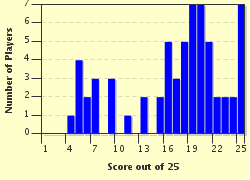Quiz Answer Key and Fun Facts
1. My name means "Fish roof". I was an aquatic animal belonging to a group called tetrapods. I lived in Greenland during the Famennian stage of the late Devonian period. Who am I?
2. My name means "Thick frog". I was a fish-eating amphibian. I lived in Scotland during the Visean stage of the early Carboniferous period. Who am I?
3. My name means "Ear lizard". I was an amphibian of the coal swamps. I lived in Canada and eastern Europe during the Moscovian stage of the late Carboniferous period. Who am I?
4. My name means 'Forest Mouse'. I'm regarded as the earliest known reptile. I lived in Canada during the Bashkirian stage of the late Carboniferous period. Who am I?
5. My name means 'Double stalk'. I was a small aquatic amphibian with a peculiar boomerang-shaped head. I lived in the USA throughout the entire Permian period. Who am I?
6. My name means 'From Seymour'. I was a small land-living amphibian. I lived in Germany and the USA during the Artinskian and Kungurian stages of the early Permian period. Who am I?
7. My name means 'Middle lizard'. I was a small freshwater reptile. I lived in Brazil and South Africa from the Asselian stage to the Kungurian stage of the early Permian period. Who am I?
8. My name means 'From Elgin'. I was a small land-living reptile. I lived in Scotland and, possibly, Russia during the Changhsingian stage of the late Permian period. Who am I?
9. My name means 'Hova lizard'. I was a small aquatic reptile. I lived in Madagascar from the Changhsingian stage and of the late Permian period to the Induan stage of the early Triassic period. Who am I?
10. My name means 'Two long teeth'. People like to think of me as a dinosaur, but I'm not. I lived in the USA during the Kungurian stage of the early Permian period, roughly one hundred and fifty million years BEFORE dinosaurs evolved. Who am I?
11. My name means 'Pavement lizard'. I was a herbivorous mammal-like reptile. I lived in Europe and the USA during from the Kasimovian stage of the late Carboniferous period to the Artinskian stage of the early Permian period. Who am I?
12. My name means 'From Jonkers'. I was a large omnivorous mammal-like reptile belonging to a group called therapsids. I lived in South Africa from the Roadian stage to the Capitanian stage of the middle Permian period. Who am I?
13. My name means 'Like a musk ox'. I was a herbivorous therapsid. I had small, chisel-shaped teeth for chopping tough vegetation. I lived in South Africa during the Wordian and Capitanian stages of the middle Permian period. Who am I?
14. My name means 'Like a dog'. I was a relatively small therapsid that looked like a cross between a crocodile and a sabre-toothed cat. I lived in South Africa from the Roadian stage to the Changhsingian stage of the Permian period. Who am I?
15. My name means 'Two weasel teeth'. I was a tiny omnivorous mammal-like reptile. I lived in South Africa during the Changhsingian stage of the late Permian period. Who am I?
16. My name means 'Plated chest'. I was a relatively small, very flat-bodied amphibian. I lived in Greenland, Sweden and Germany during the Norian stage of the late Triassic period. Who am I?
17. My name means 'High jaw'. I was a tiny land-living reptile. I lived in the USA during from the Norian stage to the Rhaetian stage of the late Triassic period. Who am I?
18. My name means 'Flat toothed'. I was a medium-sized marine reptile. I lived in Germany and Italy during the Anisian and Ladinian stages of the middle Triassic period. Who am I?
19. My name means "False lizard". I was a medium-sized marine reptile. I lived in Europe, North Africa, Russia and China during the Anisian and Ladinian stages of the middle Triassic period. Who am I?
20. My name means "Liquid lizard". I was a primitive medium-sized plesiosaur. I lived in Southern Germany during the Ladinian stage of the middle Triassic period. Who am I?
21. My name means "Lizard from the Shoshone Mountains". I was a large marine reptile. I lived in Canada and the USA during the Norian stage of the late Triassic period. Who am I?
22. My name means "Barracuda lizard". I was a small marine reptile. I lived in China during Anisian stage of the middle Triassic period. Who am I?
23. My name means "Sickle lizard". I was a tiny reptile that belonged to a group called diapsids. I'm sometimes called a monkey lizard because I was a tree-dweller. I lived in Italy during the Norian stage of the late Triassic period. Who am I?
24. I'm named after a mythological person. I was a tiny gliding lizard. I lived in the USA during the Carnian stage of the late Triassic period. Who am I?
25. My name means "Lizard without a stick". I was a medium-sized marine reptile belonging to a group called thalattosaurs. I lived in Switzerland during the Ladinian stage of the middle Triassic period. Who am I?
Source: Author
ElusiveDream
This quiz was reviewed by FunTrivia editor
rossian before going online.
Any errors found in FunTrivia content are routinely corrected through our feedback system.

